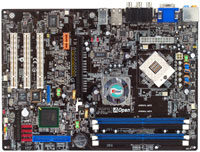Intel Core Duo (Yonah) Performance Preview - Part II
by Anand Lal Shimpi on December 19, 2005 12:55 PM EST- Posted in
- CPUs
Another issue that we had with the first article was that our comparison to the Pentium M was based on using an Intel 865 chipset; more specifically, using ASUS' CT-479 adapter and their P4P800-SE motherboard. While the motherboard itself performs quite well, we wanted a more even comparison between the Pentium M and the upcoming Core Duo processor.
 We turned to AOpen and they provided us with their i915Ga-HFS motherboard, based on Intel's mobile 915 express chipset with native support for the Pentium M processor. The biggest difference between our AOpen 915 platform and the 865 platform that we tested back in March? The 915 platform supports DDR2 memory, just like the 945 platform that we used with the Core Duo. Being able to use the exact same memory technology across both platforms removed yet another variable from our comparison, but frankly, it wasn't going to do much to the performance breakdown between the two chips.
We turned to AOpen and they provided us with their i915Ga-HFS motherboard, based on Intel's mobile 915 express chipset with native support for the Pentium M processor. The biggest difference between our AOpen 915 platform and the 865 platform that we tested back in March? The 915 platform supports DDR2 memory, just like the 945 platform that we used with the Core Duo. Being able to use the exact same memory technology across both platforms removed yet another variable from our comparison, but frankly, it wasn't going to do much to the performance breakdown between the two chips.
AOpen's board worked well during our testing, although we did have the occasional issue where the system would not POST. The issue wasn't readily repeatable, but it did happen a few times during our testing.
The only other quirk that we ran into with the AOpen board was the fact that it features absolutely no legacy ports on its I/O panel. There is support for a single PS/2 port that requires a separate bracket to be installed in your case (provided with the motherboard). Given the prevalence of USB keyboards and mice these days, it's not that big of an issue. We only mention it because the majority of our KVMs in-house are still PS/2 based.
We paired AOpen's 915 board with a Pentium M 760, which is based on the 90nm Dothan core running at 2.0GHz with a 533MHz FSB. So while the FSB speed is slower than the Core Duo that we're testing, the identical clock speed is helpful in a direct comparison between the two chips.










103 Comments
View All Comments
vailr - Monday, December 19, 2005 - link
Re: Chipset Drivers used in the review:nForce4 6.66
Intel 7.0.0.25
Check here: http://www.fdrsoft.fr.fm/">http://www.fdrsoft.fr.fm/
Intel Version 7.2.2.1006
nForce4 Version 6.70
Marlin1975 - Monday, December 19, 2005 - link
Being that DVD shrink will not be updated anymore and the creator is now part of Nero, and the Recode program. Why not use Recode?PrinceGaz - Tuesday, December 20, 2005 - link
Personally I wouldn't touch any of the compressed domain transcoders like DVD Shrink as they sacrifice quality for speed. Something like DVD Rebuilder combined with the excellent CCE SP encoder provide the best possible quality and are just as easy to use as DVD Shrink. It's nowhere near as fast as DVD Shrink, but I'll take better picture quality over saving a few minutes any day.mrred - Monday, December 19, 2005 - link
Anyone else notice that the game benches seem horribly gpu-bound? How about giving us some lower resolutions in testing?Look at FEAR in particular: X2-4200 and X2-3800 getting exactly the same score? HELLO?!?!?!? That's not a cpu-benchmark. Gimme a break.
Anemone - Tuesday, December 20, 2005 - link
Frankly I appreciate testing that shows resolutions we actually play at. Now if only we'd see 1920x1200 :)blackbrrd - Monday, December 19, 2005 - link
The games are benchmarked at 1024x768.Personally I haven't played a game below 1024x768 since I got my GF2mx four or five years ago.
Most games look horrible below 1024x768, except the games ported from consoles ;)
saratoga - Monday, December 19, 2005 - link
Yeah and above 1024 you're GPU limited. Its almost like this was a CPU review.tfranzese - Monday, December 19, 2005 - link
That's not the point. The point is to relieve the GPU so regardless of what GPUs come out a year or two from now that alieviate this bottleneck we'll have known beforehand how the CPU handles things.Further, this is a CPU preview and as such we don't care about system performance or GPU performance; that shouldn't be the focus or included in the article. Instead, every benchmark should serve the articles purpose of comparing the CPUs - GPU bound benchmarks do NOT serve that purpose and should have their resolution lowered to serve that purpose, otherwise they should not be included because what point do they serve except fluff?
tayhimself - Monday, December 19, 2005 - link
Yeah this review is horrible, just like the first Yonah review.uop - Monday, December 19, 2005 - link
I wouldn't call it horrible.There are some weak points, but it does give a good idea about how the Core Duo performs.
Mainly:
- It's not as good as the A64 when it comes to games
- FP is much improved but not there yet
The article does do a good job of reminding us that Yonah is just the dress rehersal for the real deal. Conroe is supposed to be faster, wider, and full of 64-bit goodness. Think about it - with Yonah's die size, it could be the Celeron-M in just 6 months!
If Yonah can compete with the A64, then unless AMD pull a fast one they're probably heading for the underdog position.